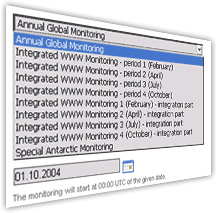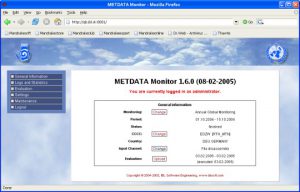NOTICE:
The METDATA Monitor was retired by WMO in July 2021. It will be replaced by other monitoring method provided by WMO.
More about the retirement you can find on WMO site (see post from 20 July 2021)
https://community.wmo.int/news/operational-newsletter
——-
New updated version with BUFR decoder updates.
Upgrade to METDATA Monitor 1.7.5-0 now.

Current ways of monitoring the data exchange on the GTS network are not optimal and it is difficult to find out the reason for that because the monitoring tools currently available are not delivering comparable results. For this reason the WMO/OMM organization has decided to provide a uniform system to monitor GTS traffic, together with an in-built support for the Integrated WWW Monitoring as well.
As a confirmation of the world-leading position of IBL Software Engineering, DWD has entrusted us with the task of developing this system, named METDATA Monitor, allowing us to greatly contribute to the harmonization of GTS monitoring tasks.
The METDATA Monitor system represents a completely new approach to the task of the GTS quantitative monitoring (for more information see the Key Differences section). Since it is officially supported by WMO/OMM, it is the best system available for the world-wide performing of the WMO/OMM monitoring programmes.
METDATA Monitor is available for free
for meteorological offices through the WMO/OMM.
Download page for METDATA
Feature Highlights
Portable & Easy
The METDATA Monitor system is a portable application based on the Java platform. Self-installation packages are available for the most common platforms including Microsoft® Windows® and GNU/Linux.
Intuitive Interface
No other monitoring tool provides a more intuitive web-based user interface well-known to normal computer users. It is possible to remotely control the METDATA Monitor system using a common web browser; each user has its own account.

General Purpose
The METDATA Monitor system can be easily extended to incorporate new types of the monitoring just by an on-line update of the system configuration. Several predefined WMO/OMM monitorings are already set up:
• Integrated WWW Monitoring (incl. new 2007 rules!)
• Annual Global Monitoring (incl. new 2007 rules!)
• Special Antarctic Monitoring
Note: Multiple monitorings can be run in parallel (e.g. AGM and IWM), then evaluated one by one and sent to WMO.
TDCF Support
- With accordance to the new rules for AGM/IWM, the METDATA Monitor system enables monitoring of TDCF bulletins (currently only BUFR). Several templates are supported:
SYNOP (RA I to RA VI) templates, - TEMP templates,
- PILOT templates.
Key Differences
Current situationThanks to METDATA MonitorMonitoring performed usually by various AMSS (Automated Message Switching Systems).Monitoring performed by METDATA Monitor.This leads to a non-unified approach.Unified approach to the monitoring task.Different level of compatibility with the WMO Manual 386 on GTS.Strict compatibility with the WMO Manual 386 on GTS.Different methods for message handling (NIL bulletins/reports counting, error checking).Unified method for message handling.Different output formats.Unified output format.Different ways of the delivery of results.Unified on-line and off-line delivery of results over the Internet.Not fully in conformance with the WMO/OMM requirements.Fully designed and implemented in conformance with the WMO/OMM requirements.The Integrated WWW Monitoring not possible or with difficulties.Full support of the Integrated WWW Monitoring.Usually manual and significantly difficult update of WMO Volumes A and C.Fully automatic on-line update of WMO Volumes A and C directly from the WMO site.Upgrading and parameterization of monitoring depends on the vendor availability and individual relations.Global on-line configuration upgrade possibility to change, extend or parameterize monitorings directly from WMO.
Technical Specifications
Operating System: Linux or Microsoft® Windows®
Compliance with WMO Manual No. 386 (Manual on Global Telecommunication System)
Throughput> 300 messages per second on normal desktop PC.
Connection Types:
- FTP standard input file formats WMO-00 and WMO-01
- Asynchronous line ZCZC/NNNN and SOH/ETX
Monitorings:
- Integrated WWW Monitoring
- Annual Global Monitoring
- Special Antarctic Monitoring
Main functions:
- collecting all data for research purposes
- configurable strictness of input parser
- automatic recognizing of input file format
- utilizing standard SQL database
- preparing evaluation reports during monitoring
- evaluation reports in viewable and printable form
- uploading of monitoring results in WMO/OMM compliant format
- online configuration of the application
- online updating of WMO Volumes A, C
- online updating and extending of available monitorings
TDCF Support:
- monitoring of BUFR bulletins
- SYNOP (RA I to RA VI) templates
- TEMP templates
- PILOT templates
Screenshots Gallery

Main screen of METDATA Monitor showing overview of its status

Automatic update of WMO Volumes

Automatic update of WMO Volumes

Evaluated results of monitoring – showing SYNOPs
